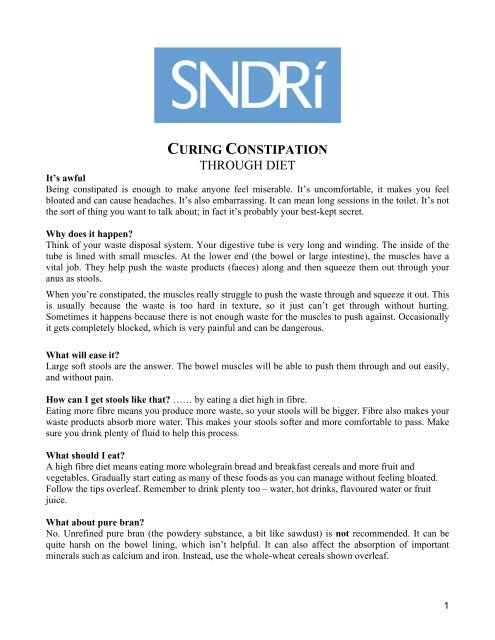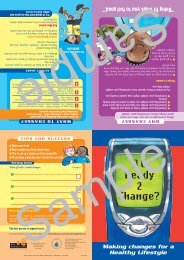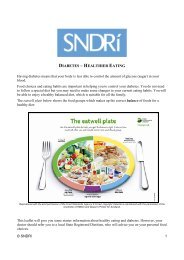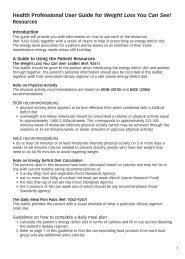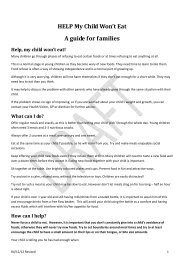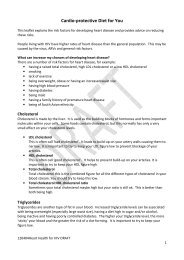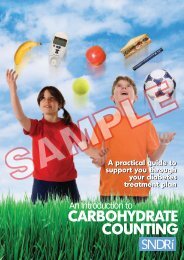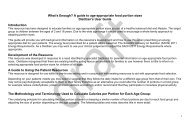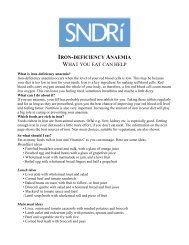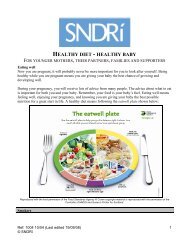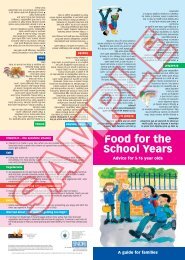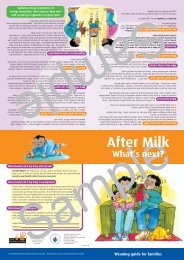CURING CONSTIPATION THROUGH DIET - NDR-UK
CURING CONSTIPATION THROUGH DIET - NDR-UK
CURING CONSTIPATION THROUGH DIET - NDR-UK
You also want an ePaper? Increase the reach of your titles
YUMPU automatically turns print PDFs into web optimized ePapers that Google loves.
<strong>CURING</strong> <strong>CONSTIPATION</strong><br />
<strong>THROUGH</strong> <strong>DIET</strong><br />
It’s awful<br />
Being constipated is enough to make anyone feel miserable. It’s uncomfortable, it makes you feel<br />
bloated and can cause headaches. It’s also embarrassing. It can mean long sessions in the toilet. It’s not<br />
the sort of thing you want to talk about; in fact it’s probably your best-kept secret.<br />
Why does it happen?<br />
Think of your waste disposal system. Your digestive tube is very long and winding. The inside of the<br />
tube is lined with small muscles. At the lower end (the bowel or large intestine), the muscles have a<br />
vital job. They help push the waste products (faeces) along and then squeeze them out through your<br />
anus as stools.<br />
When you’re constipated, the muscles really struggle to push the waste through and squeeze it out. This<br />
is usually because the waste is too hard in texture, so it just can’t get through without hurting.<br />
Sometimes it happens because there is not enough waste for the muscles to push against. Occasionally<br />
it gets completely blocked, which is very painful and can be dangerous.<br />
What will ease it?<br />
Large soft stools are the answer. The bowel muscles will be able to push them through and out easily,<br />
and without pain.<br />
How can I get stools like that? …… by eating a diet high in fibre.<br />
Eating more fibre means you produce more waste, so your stools will be bigger. Fibre also makes your<br />
waste products absorb more water. This makes your stools softer and more comfortable to pass. Make<br />
sure you drink plenty of fluid to help this process.<br />
What should I eat?<br />
A high fibre diet means eating more wholegrain bread and breakfast cereals and more fruit and<br />
vegetables. Gradually start eating as many of these foods as you can manage without feeling bloated.<br />
Follow the tips overleaf. Remember to drink plenty too – water, hot drinks, flavoured water or fruit<br />
juice.<br />
What about pure bran?<br />
No. Unrefined pure bran (the powdery substance, a bit like sawdust) is not recommended. It can be<br />
quite harsh on the bowel lining, which isn’t helpful. It can also affect the absorption of important<br />
minerals such as calcium and iron. Instead, use the whole-wheat cereals shown overleaf.<br />
1
What about laxatives?<br />
Easing constipation by changing what you eat and drink is the first line of attack. Laxatives are only<br />
advised if your GP thinks they will help. Ask your GP or pharmacist but remember that high fibre<br />
foods and plenty of fluid are still recommended.<br />
Bread and Breakfast Cereals: Eat more wholegrain or wholemeal types.<br />
INSTEAD OF<br />
White bread<br />
Sugary breakfast<br />
cereal or bacon/eggs<br />
TRY TO EAT<br />
Wholemeal or granary bread or rolls.<br />
Start with two slices a day and build it up until all your bread is wholemeal.<br />
Wholegrain breakfast cereals like Weetabix, Shreddies, Puffed Wheat or<br />
porridge or Bran breakfast cereals like Bran Flakes or All Bran - or mix Bran<br />
Flakes with Cornflakes<br />
Start having these a few times a week for breakfast or at another meal/snack<br />
time. Aim to have at least one bowl every day.<br />
Fruit: Aim to eat two or three portions a day. Fresh, frozen, tinned or dried are all excellent. Here are<br />
some ideas:<br />
• Chop banana or dried apricots onto your breakfast cereal or peel an orange as a supper snack.<br />
• Have a mini box or handful of raisins as a snack.<br />
• Enjoy chunks of pear or tinned peaches as a refreshing dessert.<br />
• Try rhubarb or apple crumble for a delicious pudding.<br />
Vegetables: Aim to have two or three servings a day. Fresh, frozen or tinned are all excellent. Here are<br />
some tips:<br />
• Plan to have two vegetables e.g. carrots and broccoli, with your main meal.<br />
• Add extra vegetables e.g. green beans, chopped swede, to your pasta sauce, casserole or pizza.<br />
• Try a chunky homemade vegetable soup with bread as a filling snack meal.<br />
• Enjoy a vegetarian main course dish e.g. vegetable casserole, for a change.<br />
• For speedy and colourful vegetables, keep peas and sweetcorn in the freezer.<br />
• Include a dish of chopped salad vegetables with your packed lunch.<br />
Pulses: Peas, lentils and different types of beans are a great source of fibre. Try to have them once or<br />
twice a week.<br />
• Try lentil soup with crusty bread.<br />
• Have baked beans on toast for a quick lunch.<br />
• Enjoy three bean salad with a baked potato.<br />
Fluid: Aim to have 6 to 9 mugs or glasses of different sorts of fluid every day (1½ to 2 litres or 3 to 4<br />
pints).<br />
• Water<br />
• Coffee<br />
• Flavoured water<br />
• Squash<br />
• Fruit juices<br />
• Milk<br />
• Tea<br />
2
This information has been produced for S<strong>NDR</strong>í by Registered Dietitians and other relevant<br />
health professionals. At the time of publication the information contained within the leaflet<br />
was, to the best of our knowledge, correct and up-to-date. Always consult a suitably qualified<br />
dietitian and/or your GP on health problems. S<strong>NDR</strong>í cannot be held responsible for how<br />
clients/patients interpret and use the information within this resource.<br />
Ref: 1002 10/04 (Last edited 19/09/08)<br />
© S<strong>NDR</strong>í<br />
3


